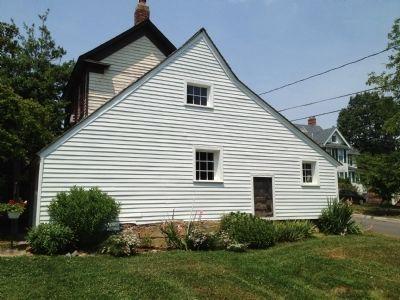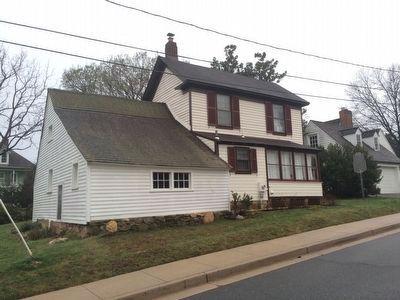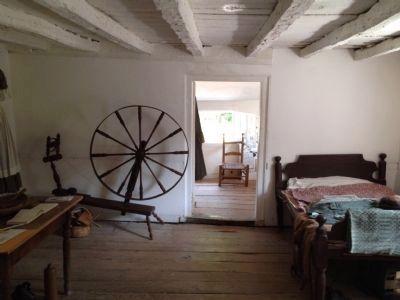Ball-Sellers House in Glencaryln

The original part of this home, a two-room log cabin with a loft, was built during the middle to late eighteenth century.
The Ball-Sellers House, probably the oldest in Arlington County, stands at 5620 Third Street, South. The original part of this home is a two-room log cabin with a loft built during the middle to late eighteenth century. The clapboard structure also includes a two-story addition made approximately a century later.
The recorded history of the property that this house sits upon began in 1742 when John Ball received a patent from Lord Fairfax for 166 acres of land along Four Mile Run, "Beginning at a white oak in the fork of Four Mile Run called the long branch .... "
At the junction of Four Mile Run and Long Branch stands a monument erected by the Glencarlyn Citizens Association in 1914, bearing this inscription: "On this spot stood an oak tree bearing a survey mark made by George Washington, which became a monumental survey mark named in many deeds." A section of that oak tree is preserved in the Glencarlyn Library.
For this land, John Ball was to pay "every year on the feast day of St. Michael the Archangel (Sept. 29) the fee rent of one Shilling sterling money for every 50 acres of Land at this moment granted.... "
John Ball and his family probably made their home on the tract shortly after he acquired it. John Ball was joined on the adjacent land by his friend Moses Ball in 1755. These two men were not close relations, although they may have been distant cousins. They both had lived in other parts of Fairfax County before acquiring the land on Four Mile Run.
John Ball's patent cites him as a resident of Fairfax in 1742, and Moses Ball's patent locates him there in 1748. Both names appear on the voter's list for the Burgesses election for Prince William County in 1741 when Fairfax was still a part of Prince William County. The ownership of 25 acres was required to vote, so both men were already landowners, probably in the Hunting Creek Valley.
John Ball cleared his land and raised corn, wheat, and tobacco. He built the log portion of the Ball-Sellers House. Although the exact date is unknown, evidence points to a date in the second half of the eighteenth century. Charles W. Stetson, in his Four Mile Run Land Grants, says the cabin may have been built in 1759. Mr. Walter M. Macomber, an eminent historical architect, has examined the house and reported:
Little detail remains in the log section, but a sufficient amount supports our belief that it was constructed during the latter part of the 18th Century. Although there is evidence of existing machine-made nails, they are easily identified with later work.
The door from the main part of the log house to the room under the lean-to roof gives us our greatest support for the dating of the building. It is hand-made with proper detail, and its hardware is also of the same period. Often, when a structure has undergone various changes that might cloud its origin, a single molding can identify its true period. The door and its trim, in our case, is sufficient proof, in my estimation, to support my belief as to the Ball-Sellers House period. Other experts have supported this thesis. John Ball also ran a mill on his land for grinding corn and wheat. A 1755 survey by Colonel John Colville, who owned an adjacent tract on Four Mile Run, mentions the "Mill House" on John Ball's land opposite the mouth of Lubber Run. There is still evidence of a mill in that location.
John Ball's will refers to his "mill stock." His estate inventory includes a grindstone, a broken pair of millstones, and a pair of new millstones, frog and spindle. John Ball died in 1766 and was probably buried in the cemetery adjacent to the Glencarlyn Library. In his will, he directed that his "land plantation and mill stock household goods wearings cloaths ... " be sold and the proceeds divided among his wife Elizabeth, and five daughters, Stacy Dowdall, Mary Hardin, Milly Thompson, Winifred Rollings, and another (name unknown) who married James Gray. William Adams and Moses Ball were named executors of the estate, but Moses Ball seems to have been the only acting executor. His inventory of the estate tells us about the possessions of an eighteenth-century farmer:
an old smooth-bore gun
an old foot adze
an old tenant saw
six sheep
two cows
two heifers
two yearlings
one gray mare
two sows and 12 pigs
one still, tub, and worm
three old axes
two bells
one saddle and bridle
plow
seven casks
four bee hives
three syder troughs
grindstone
broken pair of millstones
pair of new millstones,
frog, and spindle
Ten geese
one pair spectacles
one wooden wheel
one iron box and heaters
parcel of old books
one pair of old fire tongs
one fiddle
one oval table
one old-looking glass
five yards of woolen cloth
two old linen wheels
three beds
two old bed hides
half a dozen best plates
half a dozen Delph plates
four earthen plates
11 knives, 12 forks
four earthen pans
parcel of earthenware
pack of cards
one flax brake
one old hat, jacket, and britches
Elizabeth Ball elected to take her dower instead of her share in the will, so she retained one-third of the land until her death around 1792. Moses Ball sold the 166-acre tract to William Carlin in 1772 for one hundred pounds. William Carlin, born in Yorkshire, England 1732, came to Alexandria before 1770. George Washington's February 4, 1770 diary mentions a William Carlin of Alexandria: "At home all day. Carlin, the tailor, came here (Mt. Vernon) and stayed all night." A tailor's goose, now in the possession of Mr. Munson Lane, was an heirloom in the Carlin family of Glencarlyn, so this is probably the same man. The 1772 deed from Moses Ball to William Carlin was somehow defective, so a confirmatory deed with identical terms was drawn in 1785. However, one-third of the 166 acres was still possessed by Elizabeth Ball and could not be delivered until her death. When Virginia ceded land for the District of Columbia in 1790, the line ran through William Carlin's land, with the house on the District side and part of the land remaining in Fairfax County. When Congress assumed jurisdiction in 1800, the District of Columbia territory south of the Potomac was incorporated as Alexandria County, a name it carried until 1920, even after being ceded back to Virginia in 1846.
William Carlin lived until 1820. When he died at the age of 88, he was buried in the nearby burial ground, and his will, dated 1819, directed that his land be sold after being laid off "in lots which may be likely to suit a purchaser of small capitol." His wife, Elizabeth, and seven living children divided the proceeds. The executors, two of William Carlin's sons-in-law, Jacob Bontz and John D. Harrison, took a long time to settle the estate because finding buyers for the small lots was challenging. The widow Elizabeth Carlin died in 1835 before the estate could be settled. The final executors' report to the court in 1849 lists her funeral expenses and ten dollars paid "for old Negro Nancy" as a helper or nurse to Mrs. Carlin.
Finally, the 166-acre tract was divided into three lots, and each of William Carlin's three sons purchased one. Lot one, which contained the area occupied by the present house and was referred to as the "Mansion house tract," comprised ninety-four acres and was sold to James
Harvey Carlin about 1835 for $874. This tract corresponds to the Glencarlyn subdivision.
James Harvey Carlin probably lived in the "mansion house" after his father died in 1820. He died in the mid-1840s without leaving a will, and the deed for his parcel of land was not drawn until 1849 when his father's estate was finally settled. Thus the executors of William Carlin made the deed to James Harvey Carlin's widow, Litia, and their four children, John E. F., Ann E. A., William H. F., and Andrew W. F: two sons moved away, but Andrew and Ann continued to live on the homestead and ran a dairy and grazing farm until 1885."' Andrew added the present-day two-story structure in 1881.
When Andrew died in 1885, he left one-quarter interest in the "old Homestead estate" to Ann. She continued to farm for a year and a half with a black helper, Washington Roberts. Then, she and her brothers sold the land, and she moved to her brother William's house on adjacent
land. When she died in 1892, her will directed that headstones be erected in the Carlin cemetery for her brother Andrew and Uncle Isaac Skidmore and his wife. Some of these markers can still be seen piled in one corner of the cemetery. Ann Carlin left to Washington Roberts one hundred dollars "as evidence of his faithful services." The Ball-Sellers House had passed from Carlin's hands in 1887 when the Carlin heirs sold the "Mansion house tract" to William Curtis and Samuel F. Burdett. By now, the white oak marking the beginning of the tract was a "dead topped and anciently marked white oak." The 94 acres, plus 38 acres of an adjacent parcel, brought them $8,000. The family retained ownership of the burial ground, which was to be kept well-fenced and protected, with interment limited to members of the Carlin family. The last person to be buried in the cemetery was Mary Carlin, who died in 1905.
In the 1870s, the train from Washington began to stop at a new station near the Carlin property. The family used part of their land to develop an excursion resort called Carlin Springs with picnic grounds and a bandstand. Curtis and Burdett took advantage of this transportation to establish a residential subdivision, the final fulfillment of William Carlin's desire to divide his land for purchasers "of small capitol." Carlin Springs ( the name was changed to Glencarlyn in 1896) was the first developed community in Arlington. In 1887, the developers offered 384 lots at one hundred dollars apiece "to all men and women of moderate means or who receive stated salaries." The Corporation, later the Cooperative Association, retained the old homestead house. Dr. and Mrs. W. M. Backus lived in the Ball-Sellers House in 1887-88 while their home was under construction. Hadassah Backus, a daughter, recalled that a four-inch layer of whitewash had to be scraped off the inside of the log house with a hoe. The part of the house that still stands was then a dining room. The kitchen, which had a huge stone fireplace, was in an east wing also made of log, but was torn down in 1915. Constance and Hadassah Backus recalled standing in the fireplace to look up at the stars and sitting on an old millstone in the yard for a snack.
In 1894, a Mrs. Maxwell was employed by the county at twenty-five dollars a month to teach school in the east wing of the Ball log cabin. The old fireplace was not used, and the school was heated by a drum stove. Grades one through eight were taught to about twenty children. In 1896, Mrs. Maxwell's salary was raised to thirty-five dollars. Hadassah and Constance Backus were pupils at this school, as well as Nelson Reeves. The Ball-Sellers House was sold in 1911 to Mrs. Irene 0 . Young. In 1920, it passed to William B. Powell, who died in 1969, leaving the house to Mrs. Marian Sellers. Mrs. Sellers generously gave the house to the Arlington Historical Society in 1975, to be preserved and restored. The Society is raising funds to restore the house. The log cabin structure will be opened as a museum while the two-story addition will be occupied by a resident caretaker.
Images


